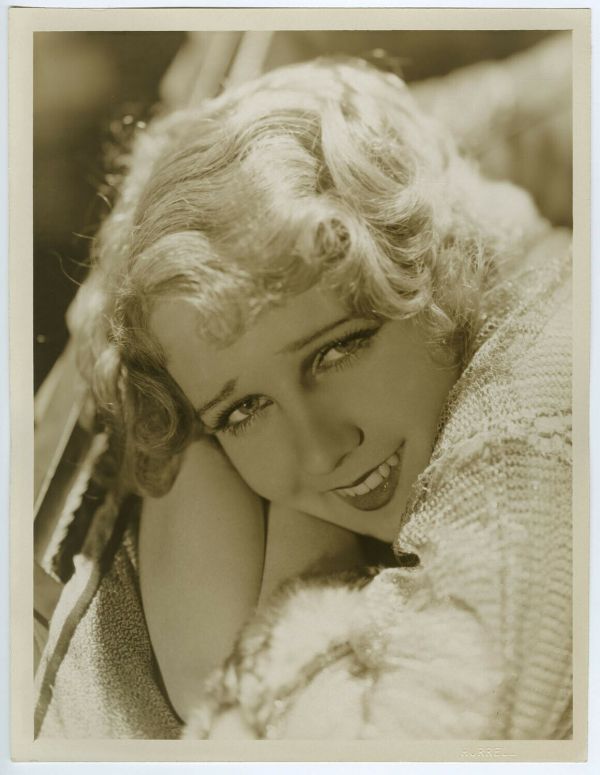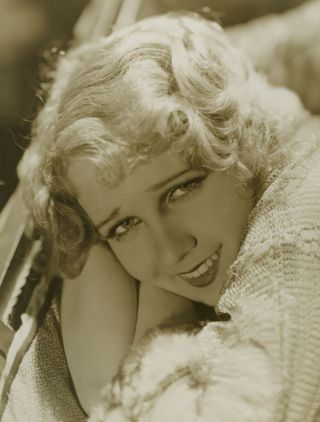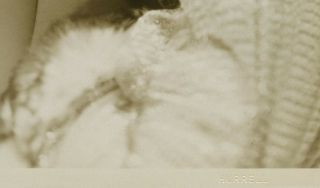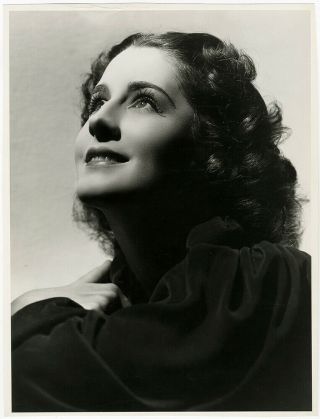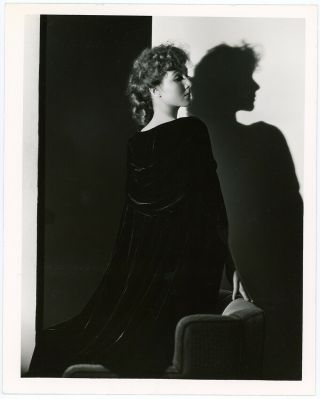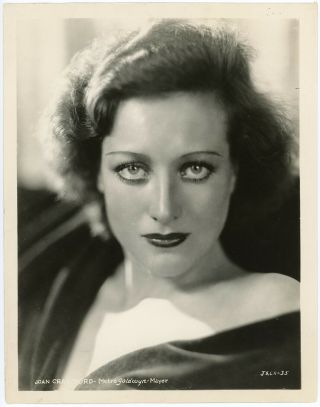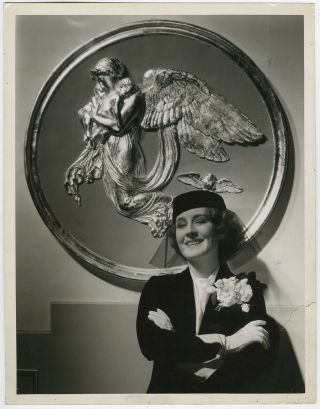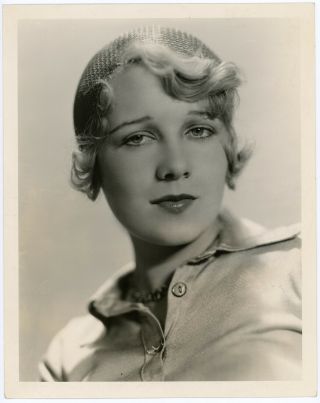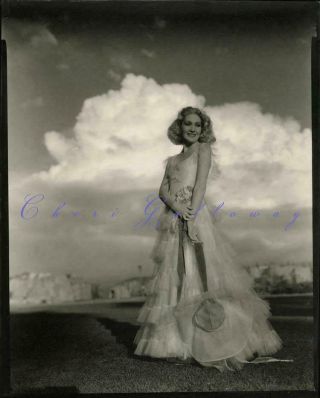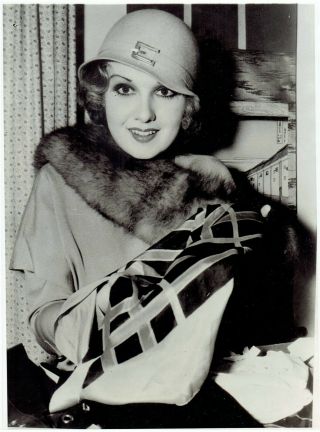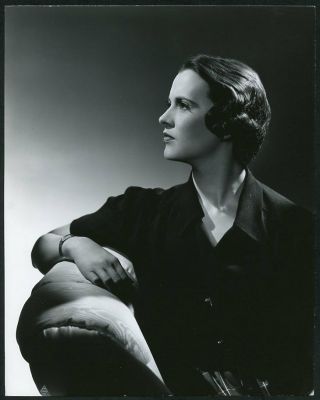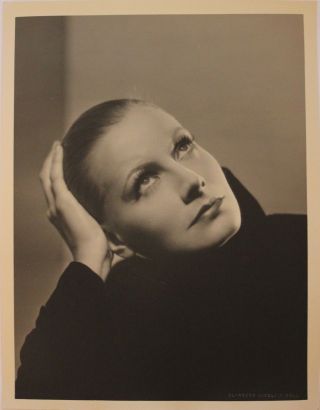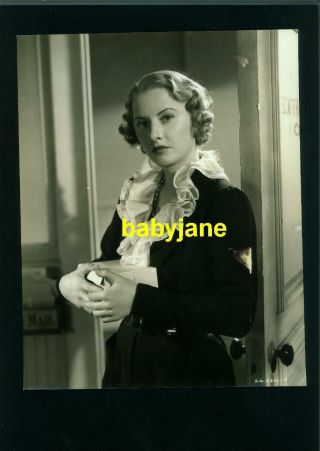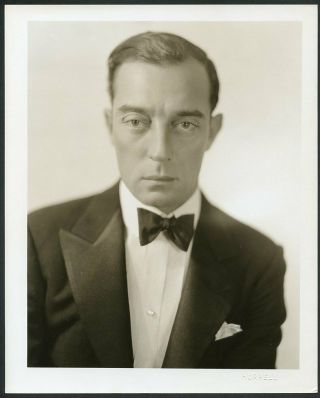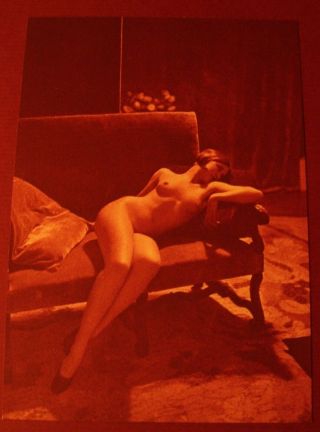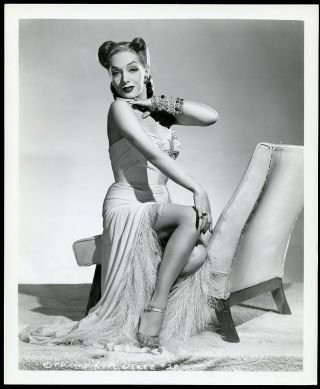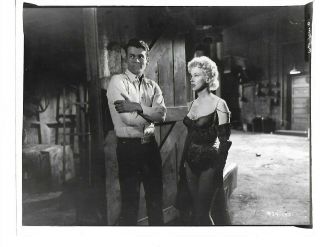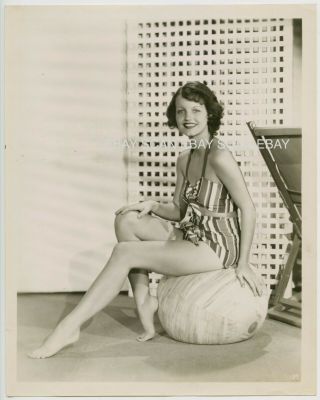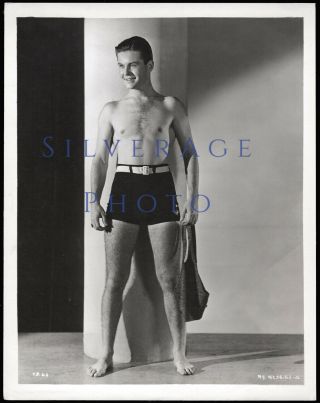Anita Page George Hurrell Vintage 30s Large Hollywood Regency Glamour Photograph
Item History & Price
Reaching peak stardom in the late silent film era, Page was reported as receiving the most fan mail out of anyone else on the MGM lot. Though she made a successful transition to sound, Page retired from acting in 1936, only returning sixty years later to appear in a handful o...f films.
Photograph measures 10" x 13" on a glossy double weight paper stock with the photographer's blind stamp in the bottom margin and MGM ink stamps on verso.
Guaranteed to be 100% vintage and original from Grapefruit Moon Gallery.
More about Anita Page:
Known as "The Girl with the Most Beautiful Face in Hollywood, " Anita Page’s career was over after only a decade, even though, at one point, she had attained a degree of popularity at MGM second only to studio queen Greta Garbo. A natural blonde with blue eyes, Page’s luminous screen presence made her fascinating to watch even in minor fare. Arriving on the scene when studios were making the switch from silent features to talkies, she was often cast as loose or otherwise amoral women. Page first found fame opposite an equally new and fresh-faced Joan Crawford in "Our Dancing Daughters" (1928) and reached her peak of notoriety following the release of MGM’s early musical hit "The Broadway Melody" (1929). She co-starred with several prominent MGM leading men, including Douglas Fairbanks, Jr., Ramon Novarro, William Haines and Robert Montgomery, and graced a pair of Buster Keaton’s sound features. Most of Page’s films were competent efforts that years later were of interest only to film buffs, but a few stood the test of time, including the splendid Lon Chaney crime drama "While the City Sleeps" (1928) and the pre-Hays Code classics "Night Court" (1932) and "Skyscraper Souls" (1932). Almost completely forgotten decades later, Page had one of the most unusual career arcs imaginable, going from regular employment at Hollywood’s premiere studio during the Golden Age of movies to small parts in grubby, shot-on-video horror movies seven decades later.
Anita Page was born Anita Evelyn Pomares in Flushing, NY on Aug. 4, 1910 and broke into the movies while still a teen. After undertaking some modelling assignments, her picture was spotted by an agent. This led to Page making some uncredited appearances – including 1926’s "Love ‘Em and Leave ‘Em, " co-starring Louise Brooks, and the comic short "Beach Nuts, " which was lensed in Cuba – before being offered contracts by both Paramount and MGM. She signed a seven-year contract with the latter, which included a starting salary of $3, 000 a week. The company paired her with established leading men like William "Billy" Haines in "Telling the World" (1928) and Lon Chaney in "While the City Sleeps" (1928) and those movies introduced Page to the public. However, when she was cast with Joan Crawford, another rising MGM starlet, Page became a popular attraction herself. "Our Dancing Daughters" (1928) was a box office smash and both actresses returned for a pair of follow-ups, "Our Modern Maidens" (1929) and "Our Blushing Brides" (1930). A fourth film, "Great Day, " was started in 1930, but ultimately never finished. In spite of their shared success in the past, the two women allegedly grew to loathe each other and did not speak when off the set.
The arrival of the talkies derailed the careers of several silent era stars, but Page made the successful transition in MGM’s musical spectacular "The Broadway Melody" (1929). The film sold a multitude of tickets and was the first Best Picture winner at the Academy Awards. Among its highlights was a scene where Charles King sings "You Were Meant for Me" to Page. She quickly became identified with the song, so the studio had Conrad Nagel croon it to her a second time in "The Hollywood Revue of 1929" (1929), though it was actually King’s voice on the soundtrack. MGM kept their new star busy, with Page doing 11 movies in two years. Her popularity soared and at one point, she was receiving over 10, 000 fan letters per week, including a number from Italian dictator Benito Mussolini proposing marriage. In spite of this adoration, Page never quite attained the A-list status of Greta Garbo, Norma Shearer or Joan Crawford. She remained an engaging presence, however, and appeared in "Gentlemen’s Fate" (1930), opposite John Gilbert, and with Buster Keaton in "Free and Easy" (1930) and "Sidewalks of New York" (1931). Two of her pictures from this stage, "Night Court" (1932) and "Skyscraper Souls" (1932) remain of particular interest to fans of pre-Code films for their soon-to-be-taboo adult themes, with Page cast as a prostitute in the latter.
By all accounts, Page enjoyed her celebrity and the privilege that came with it. She remained out of the headlines for the most part, but in addition to the feud with Crawford, she did have other unusual occurrences behind the scenes. At some point after they appeared together in "Telling the World, " Page was allegedly proposed to by Haines. Openly gay at a time when this was hardly encouraged, particularly by conservative movie studio bosses like Louis B. Mayer, Haines’ refusal to hide his preferences caused his career to nosedive. Haines may have been trying to get back on track by using the actress – who was said to be unaware of his homosexuality – as a "beard, " but ultimately his days as an actor were numbered. Another of Page’s co-stars, Ramon Novarro, was also gay and dated her for a time, reportedly with similar intent. During her time as a member of the Hollywood jet set, Page was a frequent guest of William Randolph Hearst and at one point, lived at his San Simeon castle for six months.
It was commonplace for actors under contract to be loaned to other studios, but this rarely happened to Page until 1933, when MGM began regularly farming her out to smaller studios for decidedly smaller pictures, like the Monogram potboiler "Jungle Bride" (1933) and the Clyde Beatty vehicle "The Big Cage" (1933). The actress claimed that her fall in favor at the studio was due in part to her rejecting the sexual advances of Mayer and MGM producer Irving Thalberg. The following year, Page married popular composer Nacio Herb Brown, who had scored "The Broadway Melody" and dedicated "You Were Meant for Me" to the actress, but their Tijuana union was annulled after less than a year. Her MGM contract was also now over and following a sixth billed appearance in the independently made drama "Hitch Hike to Heaven" (1936), Page decided to retire. She wed Navy Admiral Herschel House the following year and the couple remained together until his death in 1991.
It had long been assumed that there was a 60-year gap between "Hitch Hike to Heaven" and Page’s return to acting, but this proved untrue when "The Runaway" (1961) appeared on Turner Classic Movies in 2008. The family film, which featured Page in a supporting role as a nun, did not find a distributor after production finished and sat unseen for almost 50 years until it was dusted off for that TV showing. In the mid-1990s, Page made a second return, though the films at that time tended to be of a much lower quality level than the 1930s indies she had appeared in years before. Marginal releases even on video and DVD, "Sunset After Dark" (1996), "Witchcraft XI: Sisters in Blood" (2000), "The Crawling Brain" (2002), and "Bob’s Night Out" (2004) hardly made the best use of the elderly actress, though she did also share memories of her career and Golden Age Hollywood to various film historians. Page made her final appearance as Elizabeth Frankenstein in "Frankenstein Rising" (2010), which was shot in 2008, the year she died of natural causes at age 98. Page was awarded a star on the Hollywood Walk of Fame in 1960.
TCM | Turner Classic Movies Biography By John Charles
More about George Hurrell:
Recognized for his gorgeously lit, glamorous images of movie icons, photographer George Hurrell is considered one of the masters of Hollywood’s still portrait photography. An innovator as well as craftsman, Hurrell moved between studios, his independent galleries, and fashion work as the mood hit him. In fact, he could be said to suffer from attention deficit disorder, as he couldn’t sit still, and when bored, moved on to newer pastures. He remained active for decades, and his work attracts high demand, selling for high prices.
Born in Cincinnati, Ohio June 1, 1904, to a large English/Irish family, George Hurrell served as an altar boy while spending his free time drawing and studying art as a boy. While in high school, he signed up with the Quigley Seminary in Chicago to study for the priesthood, but girls and art drew him to art school instead. Short attention spans and being bored caused him to move from studying at the Chicago Art Institute to the Academy of Fine Arts and back.
In 1923, portrait photographer Eugene Hutchinson hired him as a gofer and assistant. Hurrell studied the art of photography, gaining more opportunities in the studio such as developing negatives. With extra money, he bought a used camera and began shooting studies of his own, as well as shooting artwork for artists and also continuing to paint. Landscape painter Edgar Alwyn Payne visited the Art Institute in 1925 to lecture, and viewed some of Hurrell’s artwork afterwards. He suggested Hurrell accompany him to Laguna Beach, California if he really wanted to paint, and Hurrell signed on. They arrived in the beach town on June 1, 1925, Hurrell’s birthday. Hurrell moved into director Mal St. Clair’s small bungalow, painted, explored the countryside, and began experimenting with his camera in his free time.
To earn some extra money, he made photos of artists’ paintings, and began taking portraits of artists. In late 1925, he met Florence “Pancho” Barnes at a Laguna party, and they quickly became friends. She sent Pasadena socialites his way for elegant portrait photographs. In 1926, Hurrell made photos of Payne’s work for a monograph that served as a catalog of Payne’s work for a 1926 Stendhal Gallery exhibit in Los Angeles. Little by little, photography was becoming his life. To facilitate his increasing shooting of portraits, Hurrell moved to 672 S. Lafayette Park Place, studio 9, in 1927. In 1928, he printed negatives for a visiting Edward Steichen, learning how much money a successful photographer could charge clients. He was gaining an unique style, a lush almost halo effect around his subjects. This look was achieved because he had inferior equipment that didn’t quite focus, and he also greatly retouched his negatives. Retouching would become an essential part of his look.
His friend Barnes brought along her friend, actor Ramon Novarro, in 1929. He needed elegant portraits to try and help promote a hoped for operatic tour of Europe. Hurrell shot elegant, soft focus shots of him that suggested Roman art. These photos would appear later that year in the rotogravure section of The Los Angeles Times, with the first credit, “Photo by Hurrell.” Novarro happened to show them to his friend and fellow actor Norma Shearer, who found them fascinating. She needed a hook to grab the part of a sexy vamp in the film “The Divorcee, ” so hired Hurrell for a special shoot. After difficulties in getting the proper mood, Hurrell’s clowning broke a camera and caused her to laugh, setting the stage for a successful shoot. These sensual images of her caused her husband Irving Thalberg to cast her in the role, for which she won an Academy Award. The glowing shots also earned him a job at MGM after photographer Ruth Harriet Louise left.
When Hurrell replaced Louise, he kept her assistant Al St. Hilaire to assist him and worked in the smaller of two studios on the lot; Clarence Sinclair Bull as head of the department worked in the largest. Hurrell followed his own rules, thanks to the support of Norma Shearer. While taking photos, the artist danced, goofed off, and played music, helping himself and the stars relax. Hurrell’s job was to create stunning portraits of MGM stars to run in magazines and newspapers. He shot “in-character” portraits a day after films wrapped, per Mark Vieira in his excellent book “George Hurrell’s Hollywood.” Still photographers shot like crazy on the MGM lot in 1930-1931; Vieira reports that 25, 000 negatives and 14, 000 prints a week were developed, making it a virtual shooting factory.
Hurrell created his unique look with retouching that took three hours per negative, but MGM tried to speed the process along with a retouch artist team, none of whom knew or understood Hurrell’s own unique technique. The studio and the photographer reached a compromise enabling him to hire an assistant, Andrew Korf, to retouch the negatives. Hurrell also achieved his elegant style by employing multiple lights and lenses along with having actors wear no makeup, enhanced by his deft retouching.
The photographer’s retouching technique featured several steps. He applied powdered graphite to the emulsion of the negative, then rubbed it in patterns with a rolled up paper called a blending stump. This embellished facial highlights. In the dark room, he used the printing techniques known as “burning” to increase tonal range and to make less important areas go dark and recede, per Vieira in his excellent book. One actor went even farther to improve the look of his skin; Johnny Weissmuller applied baby oil to enhance highlights, inspiring Hurrell.
To prevent boredom as well as to continue honing his skills, Hurrell began taking freelance portrait shots of other studios’ stars on the weekend. He also tended to process the photos on the MGM lot. Studio executives discovered this and the photographer quit in 1932 before they could fire him. He opened his own studio at 8706 Sunset Blvd., taking photos of stars from virtually all the lots, even MGM’s, as well as fashion shoots. Joan Crawford, his favorite model, continued using him, as they enjoyed each other’s company. She stated. “He worked to catch you off guard.” He’d shoot while the two were talking or laughing.
Hurrell began traveling to the East Coast to shoot for magazines and advertising firms, as well as entering camera shows, winning awards several years in the United States Camera Salon held in New York, per the New York Times. In 1937 he was one of the judges, along with such photographers as Arnold Genthe, Edward Steichen, Paul Outerbridge, and Will Connell, per the October 7, 1937, New York Times. Los Angeles galleries exhibited his work as well. Publications such as “Esquire” and “Vogue” featured his photographs. “Esquire” even called him the Rolls-Royce of motion picture still photographers.
In 1938, Warner Bros. hired him as portrait photographer, and Hurrell would “…devote his entire time to photographic exploitation of Warners personalities, ” per the July 25, 1938, Daily Variety. While at the studio, he added “oomph” to Ann Sheridan, as well as supposedly appearing as himself in the film “Models” in 1939 with the actress. In 1940, the studio appointed him along with 11 others such as costumer Orry Kelly, makeup man Perc Westmore, cinematographer Ernest Haller, director Anatole Litvak, to select two women contract players to groom for stardom, which the studio hoped to turn into an annual event.
Hurrell left the studio in 1940 to return to private practice, shooting for magazines in New York. In 1941, Howard Hughes paid him $4000 to glamorize Jane Russell for the film “The Outlaw, ” which would sit on the shelf for years because of censorship problems. It was Hurrell who suggested a shoot in a haystack. One of these sessions was recorded for posterity by photographer G. T. Allen of “U. S. Camera” magazine. Soon after, Hurrell set up a large studio at 333 N. Rodeo Drive in Beverly Hills. He surprisingly discovered after renting the space that actress Greta Garbo was his landlord.
The photographer soon headed to Columbia in July 1942 as a special photographic portraitist, replacing the departing A. L. Whitey Schafer. Hurrell only lasted a short time however, before applying to the Army Signal Corps. in October, per Daily Variety. While in the Army, he shot portraits for the Pentagon, but signed out in 1943, returning to Hollywood. In 1944, Hurrell supposedly appeared in the film “The Hairy Ape” as a photographer.
Hurrell decided to enter the television business in 1947, producing, hosting, and starring in a reality show “Camera Highlights” on the DuMont’s showcase time on WABD, it’s New York station. According to Variety, many camera and manufacturing companies were eager to showcase their products in the show and to act as sponsors. Hurrell would teach real amateur photographers how to improve their work after viewing samples. Unfortunately, the trade panned the show in its June 25, 1947, edition, stating, “Here’s another good television idea gone wrong through insufficient preparation, poor scripting and faulty direction.” The paper thought the adlibbing atrocious, but felt that “Hurrell demonstrated a pleasant enough video personality to hold down a weekly show, given enough time to memorize his lines.” The show failed.
The artist returned to the West Coast, and in 1950 he formed Hurrell Productions with Roy O. Disney, Gunther Lessing, and Paul Pease, to make live action and animated features and TV films, shooting on the Disney lot, per the December 13, 1950, Daily Variety. Several years before, Hurrell had married Walt Disney’s niece, which aided him in setting up the deal. The company existed for several years, but mostly focused on commercial work. He returned to East Coast fashion shoots.
Hurrell headed the Twentieth Century-Fox Studios portrait department, shooting for TV shows and films like “Star!” and “Bang Bang”in the 1960s. The difficult stars and cheaper conditions both angered and saddened him. He complained to the Los Angeles Times on June 1, 1969 that “Working on a movie now is like being a combat photographer.” Stars now refused to pose, arrived late, or acted up, not like in the golden era. As he stated, “In the old days when a star was asked to pose for a publicity still, they posed and no nonsense.”
His work was also featured in major camera shows at places like the Museum of Modern Art in 1965 along with works of photographers like Cecil Beaton, Julia Margaret Cameron, Irving Penn, Edward Steichen, Man Ray and Richard Avedon. Hurrell’s portraits also appeared in Los Angeles exhibits. The photographic world now considered him a master as well.
Hurrell released his book “The Hurrell Style” in 1976 with text by Whitney Stine, featuring stories and commentaries from the photographer. He began making appearances talking about his work, and his photographs appeared in many exhibitions. A documentary about his life and career called “Legends in Light” was released in 1995 after his death, but “Variety” felt it revealed little of the man himself. The review did point out that the show revealed his still energetic and enthusiastic personality at the age of 87.
Biography From: Mary Mallory: Hollywood Heights – George Hurrell



